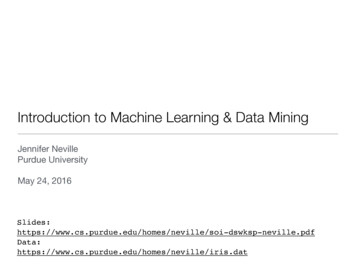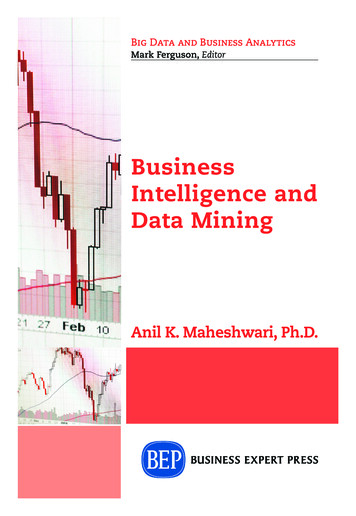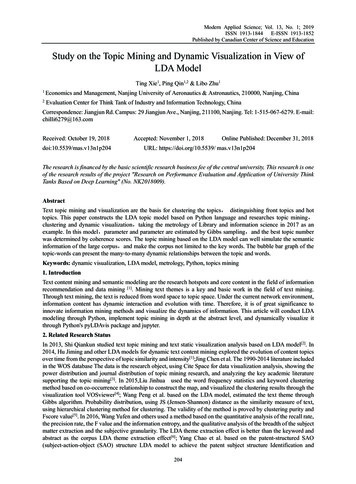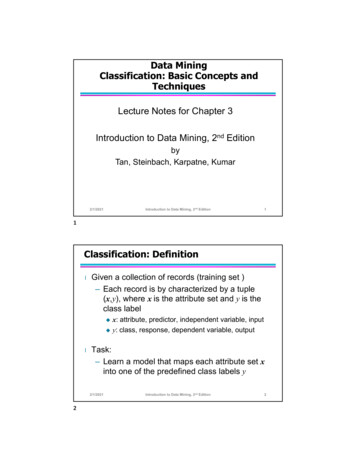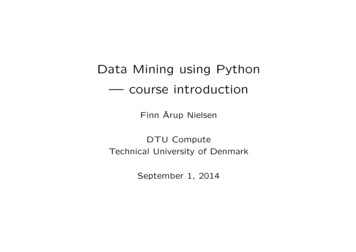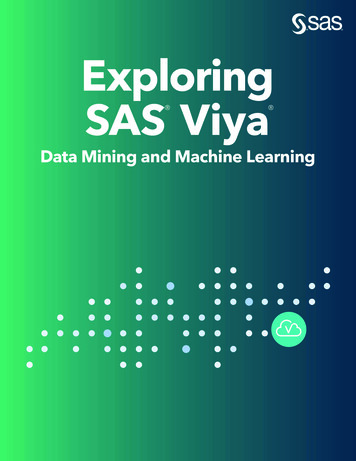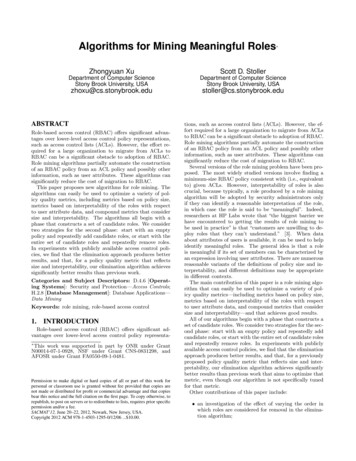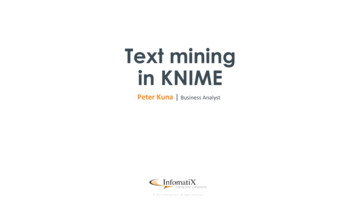
Transcription
Data Mining IIntroduction and Course OutlineHeiko Paulheim
Hello Prof. Dr. Heiko Paulheim– Chair for Data Science Research Interests:– Knowledge Graphs on the Web and their Applications– Data Quality and Data Cleaning on Knowledge Graphs– Using Knowledge Graphs in Data Mining– Societal Impact of Artificial Intelligence Room: B6 26, B0.22 Consultation: Tuesdays 9-10– Please make an appointment with Bianca Lermer upfront Heiko will teach the lectures9/28/20Heiko Paulheim2
Hello M.Sc. Nicolas Heist Graduate Research Associate Research Interests:– Semantic Web Technologies– Knowledge Graphs and Linked Data eMail: nico@informatik.uni-mannheim.de Nico will teach the RapidMiner exercisesand co-supervise the team projects.9/28/20Heiko Paulheim3
Hello M.Sc. Sven Hertling Graduate Research Associate Research Interests:– Semantic Technologies / Semantic Web– Linked Data– Knowledge Graphs eMail: sven@informatik.uni-mannheim.de Sven will teach the Python exercisesand co-supervise the team projects.9/28/20Heiko Paulheim4
Hello M.Sc. Ralph Peeters Graduate Research Associate Research Interests:– Entity Matching using Deep Learning– Product Data Integration– eMail: ralph@uni-mannheim.de Ralph will teach the Python exercisesand co-supervise the team projects.9/28/20Heiko Paulheim5
Introduction and Course Outline Course Outline and Organization What is Data Mining? Methods and Applications The Data Mining Process9/28/20Heiko Paulheim6
Course Organization Lecture– introduces the principle methods of data mining– discusses how to evaluate generated models– presents practical examples of data mining applicationsfrom the corporate and Web context Exercise– students experiment with data sets using RapidMiner or Python Project Work– teams of five students realize a data mining project– teams may choose their own data sets and tasks(in addition, we will propose some suitable data sets and tasks)– write summary about project, present project results Final grade– 75 % written examIf you fail the exam, but do a good project,you may still pass.– 25 % project work (20% report, 5% presentation)9/28/20Heiko Paulheim7
Exercises of Your Choice Exercises in RapidMiner– Thursday, 12 – 13.30– Requires no programming knowledge Exercise in Python– Thursday, 13.45 – 15.15 and 15.30 – 17.00Introduction to Pythonand Jupyter Notebookstoday, 15.30,in this room!– Requires programming knowledge Exercises start tomorrow!9/28/20Heiko Paulheim8
Course Outlineyou are here9/28/20Heiko Paulheim9
Deadlines Submission of project work proposal– Monday, Nov 2nd, 23:59 Submission of final project work report– Firday, Dec 23rd, 23:59 Project presentations– schedule to be announced– everyone has to attend9/28/20Heiko Paulheim10
Course Organization Lecture Webpage: Slides, Announcements– ning– hint: look at version tags! Additional Material– ILIAS eLearning System, https://ilias.uni-mannheim.de/ Time and Location– Lecture: Wednesday, 10.15 – 11.45, WIM-ZOOM-02– Exercises: Thursdays:12.00 – 13.30 (RapidMiner w/ Nicolas), WIM-ZOOM-0213.45 – 15.15 (Python w/ Sven), WIM-ZOOM-0215.30 – 17.00 (Python w/ Ralph), WIM-ZOOM-02 these are three parallel groups, you only have to attend one9/28/20Heiko Paulheim11
Course Organization Registration– you have registered via Portal2– and been added to ILIAS There is a waiting list– if you decide not to continue, please email Ms. Czanderle– we will reassign your place9/28/20Heiko Paulheim12
Course Organization – Corona Specials Lectures and Exercises– take place via ZOOM Lectures and Exercisesare streamed live– We will try to record lecturesand provide the recordings– We will not record exercisesfor legal reasons Project coaching and presentations– will take part via ZOOM The written exam will taken place on campus– At least as of today.9/28/20Heiko Paulheim13
Literature & Slide Sources Pang-Ning Tan, Michael Steinbach, Vipin Kumar:Introduction to Data Mining,Pearson / Addison Wesley.– 10 copies in university library.– we provide scans of important chapters via ILIAS Ian H. Witten, Eibe Frank, Mark A. Hall:Data Mining: Practical Machine LearningTools and Techniques, 3rd Edition, Morgan Kaufmann.– several copies in university library– we provide scans of important chapters via ILIAS9/28/20Heiko Paulheim14
Literature & Slide Sources Bing Liu: Web Data Mining, 2nd Edition, Springer.– several copies in university library– electronic edition available via the library Gregory Piatetsky-Shapiro, Gary Parker:KDNuggets Data Mining course:http://www.kdnuggets.com/data mining course/9/28/20Heiko Paulheim15
Literature – Rapidminer1.Markus Hofmann, Ralf Klinkenberg:RapidMiner: Data Mining Use Cases andBusiness Analytics Applications.Chapman & Hall, 2013. Explains along case studies how to usesimple and advanced Rapidminer features. 2.Website with data and processes:http://rapidminerbook.comMatthew North: Data Mining for the Masses.Global Text Project, 2012. Free PDF version available online.3.Rapidminer – User Manual introduction to user interface and basic features http://rapidminer.com/learning/getting-started/
Literature – Python McKinney: Python for Data Analysis Severance: Python for Everybody:Exploring Data in Python 3 Coelho and Richert: Building Machine Learning Systemswith Python – Free Online Access via university library Online Sources:– https://www.learnpython.org/– https://docs.python.org/3/tutorial/– 9/28/20Heiko Paulheim17
Additional Material Video recordings from FSS 2015– lecture-videos/9/28/20Heiko Paulheim18
Outlook: Data Mining II Taught every FSS Topics– Sequential Pattern Mining, Time Series Prediction– Neural Networks and Deep Learning– Anomaly Detection– Online Data Analysis– Advanced Data Preprocessing Practical project– The annual Data Mining Cup– Worldwide competition of student teams– Real-world data mining tasks9/28/20Heiko Paulheim19
Questions?9/28/20Heiko Paulheim20
A Bit of History We are drowning in data, but starving for knowledge.(John Naisbitt, 1982) Computers have promised us a fountain of wisdom but delivered aflood of data. It has been estimated that the amount of information in the worlddoubles every 20 months.(Frawley, Piatetsky-Shapiro, Matheus, 1992)9/28/20Heiko Paulheim21
“We are Drowning in Data.”More and more datais generated:– Transaction datafrom banking,telecommunication,e-commerce– Scientific data fromastronomy, physics, biology– All interactions with the Web– Social network sites– Application logs– GPS tracking logs– .9/28/20Heiko Paulheim22
Data, Information, Knowledge, and WisdomGene Bellinger, Durval Castro and Anthony Mills. "Transforming Data to Wisdom."9/28/20Heiko Paulheim23
A Historical Example Cholera disease From beginning of 19th century 100,000 deaths per year– until today! For a long time,there was little knowledge– on ways of infection– on causes of the snet combating cholera 1.html9/28/20Heiko Paulheim24
A Historical Example August Heinrich Petermann 1822-1878 Geographer and Cartographer Geographic maps as a means– to understand data– to gather gust Heinrich Petermann.jpg9/28/20Heiko Paulheim25
A Historical Example 1848 map of Cholera deaths in London– finding: Cholera is more likely in densely populated areas– where there is no functioning sewage system– conclusion: Cholera is transmitted through contaminated waterhttp://www.dgfk.net/index.php?do dbk&do2 12099/28/20Heiko Paulheim26
A Recent Example: the NSA Communication data from all over the world Searching forsuspects eiko Paulheim27
A Recent Example: the o Paulheim28
A Very Recent Example: CoViD-19ᅵ9/28/20Heiko Paulheim29
A Very Recent Example: CoViD-19 Data Mining can help understanding– pathways and chains of infection– critical preconditions of patients previous diseases medications genetic preconditions– effectiveness of prevention strategies e.g., famous hammer & dance paper– vulnerable factors in health infrastructures9/28/20Heiko Paulheim30
“We are Drowning in Data.”The following slides aretaken from Aidan Hogan's courseon “Massive Data Processing”Wikipedia (en, text only) 20 GB of data1 Wiki 1 Wikipedia9/28/20Heiko Paulheim31
“We are Drowning in Data.”Human Genome 4 GB/person 0.2 Wiki/person 1.6M Wiki/humankind9/28/20Heiko Paulheim32
“We are Drowning in Data.”US Library ofCongress 235 TB archived 11.7M Wiki9/28/20Heiko Paulheim33
“We are Drowning in Data.”Sloan Digital SkySurvey 200 GB/day 73 TB/year 3.7k Wiki/year9/28/20Heiko Paulheim34
“We are Drowning in Data.”NASA Center forClimate Simulation 32 PB archived 1.6M Wiki9/28/20Heiko Paulheim35
“We are Drowning in Data.”Facebook 12 TB/day added 600 Wiki/day 219k Wiki/year(as of Mar. 2010)9/28/20Heiko Paulheim36
“We are Drowning in Data.”Large Hadron Collider 15 PB/year 750k Wiki/year9/28/20Heiko Paulheim37
“We are Drowning in Data.”Google 20 PB/day processed 1M Wiki/day 365M Wiki/year(Jan. 2010)9/28/20Heiko Paulheim38
“We are Drowning in Data.”Internet (2016) 1.3 ZB/year 65M Wiki/year(2016 IP traffic; Cis co e s t.) 2 Wiki/second9/28/20Heiko Paulheim39
“We are Drowning in Data.”9/28/20Heiko Paulheim40
.but starving for knowledge! Rate at which data are produced Rate at which data can be understoodmanual interpretation is hardly feasible!9/28/20Heiko Paulheim41
Data Mining: Definitions Idea: mountains of data– where knowledge is mined9/28/20Heiko Paulheim42
Data Mining: Definitions Data Mining is a non-trivial process of identifying– valid– novel– potentially useful– ultimately understandablepatterns in data.(Fayyad et al. 1996) Data mining is nothing else than torturing the data until it confesses(Fred Menger, year unknown) .and if you torture it enough, you can get it to confess to anything.9/28/20Heiko Paulheim43
Origins of Data Mining Draws ideas from machine learning, statistics, and databasesystems. Traditional techniquesmay be unsuitable due to– large amount of dataStatistics– high dimensionalityof data– heterogeneous,distributed natureof dataMachineLearningData MiningDatabaseSystems9/28/20Heiko Paulheim44
Data Mining Application Fields Business– Customer relationship management, e-commerce,fraud detection, manufacturing, telecom, targeted marketing, healthcare, Science– Data mining helps scientists to analyze data and toformulate hypotheses.– Astronomy, physics, bioinformatics, drug discovery, Web and Social Media– advertising, search engine optimization, spam detection,web site optimization, personalization, sentiment analysis, Government– surveillance, crime detection, profiling tax cheaters, 9/28/20Heiko Paulheim45
Data Mining Methods Descriptive methods– find patterns in data– e.g., which products are often bought together? Predictive methods– predict unknown or future values of a variable given observations (e.g., from the past)– e.g., will a person click an ad? given his/her browsing history Machine learning terminology:– descriptive unsupervised– predictive supervised9/28/20Heiko Paulheim46
Data Mining Tasks Clustering (descriptive) Classification (predictive) Regression (predictive) Association Rule Mining (descriptive) Text Mining (both descriptive and predictive) Covered in Data Mining 2– Anomaly Detection (descriptive)– Sequential Pattern Mining (descriptive)– Time Series Prediction (predictive)9/28/20Heiko Paulheim47
Clustering Given a set of data points, and a similarity measure among them,find clusters such that– Data points in one cluster are similar to one another– Data points in separate clusters are different from each other Result– a descriptive grouping of data points9/28/20Heiko Paulheim48
Clustering: Applications Application area: Market segmentation Goal: Subdivide a market into distinctsubsets of customers– where any subset may be conceivedas a marketing target to be reachedwith a distinct marketing mix Approach:– Collect information about customers– Find clusters of similar customers– Measure the clustering quality by observing buying patternsof customers in same cluster vs. those from different clusters9/28/20Heiko Paulheim49
Clustering: Applications Application area: Document Clustering Goal: Find groups of documents that are similar to each otherbased on the important terms appearing in them Approach– Identify frequently occurring terms in each document– Define a similarity measure based on the frequencies ofdifferent terms Application Example:Grouping of storiesin Google News9/28/20Heiko Paulheim50
Classification Given a collection of records (training set)– each record contains a set of attributes– one of the attributes is the class (label) that should be predicted Find a model for class attribute as a function of the values of otherattributes Goal: previously unseen records should be assigned a class asaccurately as possible– A test set is used to validate the accuracy of the model– Training set may be split into training and validation data9/28/20Heiko Paulheim51
Classification ExampleClass/LabelAttributeRefund MaritalStatusTaxableIncome CheatNoSingle75K?Tid RefundMaritalStatusTaxableIncome oNoMarried150K?3NoSingle70KNoYesDivorced 90K?4YesMarried120KNoNoSingle40K?5NoDivorced 95KYesNoMarried80K?6NoMarriedNo7YesDivorced es60K109/28/20Heiko l52
Classification: Applications Application area: Direct Marketing Goal: Reduce cost of mailing by targetinga set of consumerswhich are likely to buy a new cell phone Approach:– Use the data for a similar product introduced before– We know which customers decided to buy and which did not– Collect various demographic, lifestyle, and company-interactionrelated information about all such customers Type of business, where they stay, how much they earn, etc.– Use this information as input attributes to learn a classifiermodel9/28/20Heiko Paulheim53
Classification: Applications Application area: Fraud Detection Goal: Recognize fraudulent cases incredit card transactions Approach:– Use credit card transactions and the informationon its account-holder as attributes When and where does a customer buy? What does s/he buy? How often s/he pays on time? etc.– Label past transactions as fraud or fair transactionsThis forms the class attribute– Learn a model for the class of the transaction– Use this model to detect fraud by observing credit cardtransactions on an account9/28/20Heiko Paulheim54
Association Rule Discovery: Definition Given a set of records each of which contain some number of itemsfrom a given collection produce dependency rules which will predict occurrence of an itembased on occurrences of other items.TIDItems1Bread, Coke, Milk23Beer, BreadBeer, Coke, Diaper, Milk45Beer, Bread, Diaper, MilkCoke, Diaper, Milk9/28/20Heiko per,Milk}Milk} {Beer}{Beer}{Milk}{Milk} {Coke}{Coke}55
Association Rule Discovery: Applications Application area: Marketing and Sales Promotion Example rule discovered:{Bagels, Coke} -- {Potato Chips} Insights:– promote bagels to boost potato chips sales– if selling bagels is discontinued, this will affect potato chips sales– coke should be sold together with bagels to boost potato chipssales9/28/20Heiko Paulheim56
Association Rule Discovery: Applications Customers who bought this product also bought – .do terrorists order bomb building parts on frequently-bought-together/9/28/20Heiko Paulheim57
Association Rule Discovery: Applications Content-based recommendation– requirement: much data– e.g., Amazon transactions,Spotify logfiles9/28/20Heiko Paulheim58
Association Rule Discovery: Applications Real world example:– Customer loyalty en-mehrere-partnerunternehmen/9/28/20Heiko Paulheim59
Association Rule Discovery: Applications Real example:– Target (American grocery store)– Analyzes customer buying behavior– Sends personalized advertisement Famous case in the USA:– Teenage girl gets advertisement for baby products– .and her father is t-before-her-father-did/9/28/20Heiko Paulheim60
Association Rule Discovery: Applications Bottom line of the Target teenage girl story:– Janet Vertesi, Princeton university– Tried to hide her pregnancy from computers Measures taken:– using Tor for online surfing– no social media posts about her pregnancy– paying all pregnancy/baby related products in cash– a fresh Amazon account delivering to a local locker paying with cash-payed gift cards Outcome:read the full story y/– massive buying of gift cards in a convenience storewas reported to tax authorities9/28/20Heiko Paulheim61
The Data Mining ProcessSource: Fayyad et al. (1996)9/28/20Heiko Paulheim62
The Data Mining Process Note that none of those steps actually requires a computer Recall Petermann's Cholera maps– Data Selection: find data on cholera deaths– Data Preprocessing: organize data by geographic area– Transformation: draw data on a map– Data Mining: look at the map and find patterns possibly step back: add more data (population, water system, .)– Interpretation: Cholera is transmitted via contaminated water However, computers make things easier– mainly: scalability (size of datasets, number of patterns)– avoiding human bias9/28/20Heiko Paulheim63
Selection and Exploration Selection– What data is available?– What do I know about theprovenance of this data?– What do I know about the qualityof the data? Exploration– Get an intitial understanding of the data– Calculate basic summarization statistics– Visualize the data– Identify data problems such asoutliers, missing values,duplicate records9/28/20Heiko Paulheim64
Selection and Exploration Visual Data Mining– For exampleas maps– Example:Map showingmigration streamsand net migrationof ation-map.html9/28/20Heiko Paulheim65
Preprocessing and Transformation Transform data into a representation that is suitable for the chosendata mining methods– number of dimensions– scales of attributes (nominal, ordinal, numeric)– amount of data (determines hardware requirements) Methods– Aggregation, sampling– Dimensionality reduction / feature subset selection– Attribute transformation / text to term vector– Discretization and binarization Good data preparation is key to producing valid and reliable models Data preparation estimated to take 70-80% of the time and effort of adata mining project!9/28/20Heiko Paulheim66
Data Mining Input: Preprocessed Data Output: Model / Patterns1. Apply data mining method2. Evaluate resulting model / patterns3. Iterate:– Experiment with different parameter settings– Experiment with different alternative methods– Improve preprocessing and feature generation– Combine different methods9/28/20Heiko Paulheim67
Interpretation / Evaluation Output of Data Mining– Patterns– Models In the end, we want to derive value from that, e.g.,– gain knowledge– make better decisions– increase revenue9/28/20Heiko Paulheim68
What you will learn in this lecture Common data mining tasks– How they work– When and how to apply them– How to interpret their output9/28/20Heiko Paulheim69
Data is the New. Oil (2006)9/28/20 Heiko PaulheimCO2 (2019)70
Questions?9/28/20Heiko Paulheim71
– introduces the principle methods of data mining – discusses how to evaluate generated models – presents practical examples of data mining applications from the corporate and Web context Exercise – students experiment with data sets using RapidMiner or Python Project Work – teams of fiv


